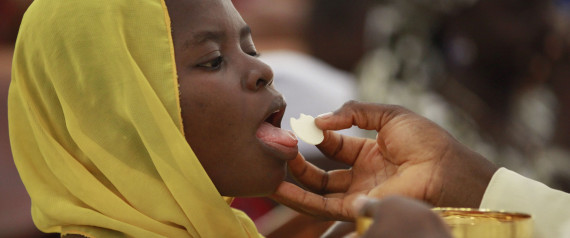Posted on 28 June 2011 by Ron Conte
From the Cross within Time, and yet from all Eternity, Christ saves. Christ’s saving work reached its apex, at a certain point in Time, with His sacrifice on the Cross. And yet the redeeming sacrifice of Christ on the Cross “participates in the divine eternity, and so transcends all times.” (CCC, n. 1085). From Heaven, the blessed constantly view Christ suffering and dying for our salvation on the Cross. The Sacrifice of Christ on the Cross is ever present tense to the Blessed in Heaven. Grace continually pours forth from Christ on the Cross to the Blessed in Heaven. Grace continually pours forth from Christ on the Cross to all of God’s children throughout Time and Place.
From the Cross within Time, and yet from all Eternity, Christ dispenses grace. God’s merciful grace, flowing from Christ on the Cross, is not limited or obstructed by Time. For God is Eternity, just as God is Love, is Mercy, is Justice, is Truth. The Most Blessed Trinity pours out immeasurable merciful grace through Jesus Christ and the Virgin Mary upon all of Creation, throughout all Time and Place, and beyond Time and Place, from timelessness Eternity.



4 comments:
Jesus must be Catholic, otherwise his Church, which follows him and is promised his fullness, could not be called Catholic. Being Catholic means embracing everything, leaving nothing out. How can an individual human being do this, even if he is the only begotten Son of God?
We shall not explain this by theological speculation. It is something that can reveal itself to us only if, in the openness of faith, we let our eyes rest on his self-manifestation.
He is the revelation of someone else, of the Father, who is "greater" than he, and yet with whom he is "one". This is the message of his words and his life.
He can reveal the Father in this way only through a twofold movement: he steps forward (with divine authority) in order to make the Father visible, and simultaneously he steps back (as the Suffering Servant) in order to reveal the Father, not himself.
We must not fail to discern him in his mode of stepping back, for he is the only way to the Father. In other words, the Father reveals himself by revealing the Son; he gives himself by giving his Son: dando revelat, et revelando dat (Bernard). Nor must we cling to him in his stepping forth, for, in all the density of his flesh, his whole aim is to be transparent, revealing the heart of God.
In the same breath he can say, "My flesh is food indeed" and "It is the spirit that gives life, the flesh is of no avail." We must not hedge him round with a pietistic Jesus-spirituality on the grounds that "only the Son knows the Father"; he is the Door, and a door is not for clinging to: it is for going through.
He is "the way": we are not meant to stand still on it but walk along it, toward "my Father's house", which has "many rooms". And at the same time we do not leave these rooms and this path behind us, for Jesus is also the light of the world, the truth, the Resurrection, the presence of eternal life. But he is these things, not in his own power, but because he manifests the Father's love.
Lest we become completely confused and wearied by this riddle of his simultaneous stepping forward and stepping back, his appearances and disappearances, he goes beyond it: when he rises from the dead and goes back to the Father, he sends the Holy Spirit from the Father. This Holy Spirit is the one, whole, personal manifestation and confirmation of this baffling unity between Father and Son, the divine "We" that is more than the mere "I" and "Thou".
It leads beyond the endless process of counting up, of supplementary definitions, to the reality of mutual presence and indwelling, without causing Father and Son to submerge in the Spirit. The Spirit comes to the aid of our helplessness in the face of the unity of opposites so clearly expressed in the gospel.
He rewards us for not trying to resolve this apparent contradiction by our own efforts-for this would be to destroy the core of the Catholic reality: if we are to see things properly, we must include the opposite of what we have seen. It is not that what we see suddenly turns ("dialectically") into its opposite, but that in the lowliness of Jesus there is a direct revelation of his lofty nature; that in his severity we discern his mercy, etc.
And it is not that, in his human lowliness, he shows the greatness of the divine Father; it is not that his human severity prepares the way for the Father's compassion. Rather, his lowliness reveals the humiliation of the Father's love, and that shows his greatness.
Thus, too, his human severity reveals the unshakable nature of the Father's love, and hence of its compassion. So, in the distinction between Father and Son, we discern simultaneously the unity of the divine essence, and, within it, the possibility of uniting those qualities that seem to us irreconcilable.
The famous Catholic "and"--Scripture "and" Tradition, etc.--which is the object of Protestant criticism, has its true origin here, and here alone.
Jesus Is Catholic | Hans Urs von Balthasar | From In The Fullness of Faith: On the Centrality of the Distinctively Catholic
Post a Comment